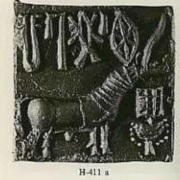IVC -Ankh symbol means life
IVC – “Ankh” symbol means “life”
Abstract
Many important symbols of IVC are derived from ancient Egyptian civilisation. Hence, I naturally expected the important ankh symbol to be in modified form in the Indus script. The Ankh symbol is present in IVC, but in a confusing form.
Figure 1Arrow symbol variants as per Mahadevan
The arrow symbol variants are as per Mahadevan. He grouped only two symbols under this category, whereas the classification of Mohenjo-daro.com groups many symbols under this category. These variants are as listed in the Indus script fonts file. Details are given below. These variants are from the book by Asko Parpola. (1)
Figure 2Arrow symbol variants as per Mohenjo-Daro.com.
The Ankh symbol represents life (immortality) and death. It can also represent zest, joy of life, and energy. The ancient Egyptians used the ankh to stand for a word that meant life. It is also called crux ansata, Latin for cross-with-a-handle. Like most religious or spiritual symbols, the Ankh Cross has no single, simple meaning.
The seal inscription beside it shows an ankh-like symbol that means life. The three symbols are read as follows: Kedaga (protection of life), Life (ankh symbol), ritual on Astaka day (Eighth day). One crucial point to be noted here is that the ankh symbol looks like a cross, not an arrow, whereas Mahadevan classifies everything into an arrow symbol. This classification of Mahadevan is leading to confusion.
The seal inscription reads like this: (Read from right to left.) It is the same message as in the earlier seal. Kedaga – Ankh (Life) – ritual on Astaka day. There is no god mentioned. Just “life” is mentioned.
The first two symbols read as follows(Read from left to right): Life (Ankh) – Sastha (Branch symbol). Only one god could give life in IVC: god “Heh”, the seventh day god. He is called “Ayyappan” in South India at present.
Mahadevan’s data mentions the seventh day god only once in a triplet. Data analysis shows that no specific god is aligned with this life-giving ankh symbol. The significant pairing frequency occurs with the Astaka symbol (Ritual on the eighth day). Details are given in the table below.
| This symbol pair occurs 19 times. | However, the second arrow |
|
| This pair occurs 4 times. | This symbol pair reads as “Ankh Sastha”. Ankh Sastha is the god “Heh”. This combination is logical and meaningful. |
The second arrow shown by Mahadevan is not correct. The second arrow symbol has a distinct loop on the top of the arrow, like an ankh symbol. Mahadevan has not classified this ankh symbol as a separate symbol. (2) He has omitted the ankh symbol and taken it as an arrow symbol. Hence, the frequency data that Mahadevan provided is unreliable for this ankh symbol. Based on the above discussion, it can be concluded that the Ankh symbol was present in IVC, with the same meaning as that of the Egyptian hieroglyphic meaning. The god who gave everlasting life in IVC was god “Heh”, he is still being worshipped in the name of “Ayyappan” in South India. (3)
References
1. Parpola, Asko (a). Deciphering the Indus script. New York : Cambridge University Press, 2000.
2. RMRL, Mahadevan. [Online] Mahadevan, Iravatham & Roja Muthiah Research Library (2021), The Indus Script Web Application(IM77/IDF80). https://indusscript.in.
3. Jeyakumar(Ayyappan). [Online] 2015. https://www.academia.edu/31640471/Ayyappan_and_Ayyanar_the_difference_is_explained?email_work_card=reading-history.

